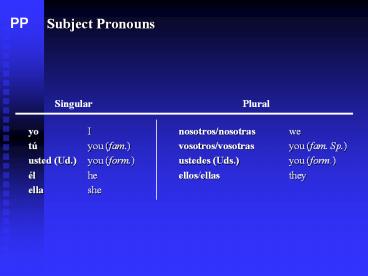nosotros/nosotras we - PowerPoint PPT Presentation
1 / 10
Title:
nosotros/nosotras we
Description:
Expressing Direct and Indirect Objects Together Double Object Pronouns: ... him, her, it them Expressing Likes and Dislikes The Verb gustar Spanish Me gusta la ... – PowerPoint PPT presentation
Number of Views:67
Avg rating:3.0/5.0
Title: nosotros/nosotras we
1
Subject Pronouns
PP
Singular
Plural
- nosotros/nosotras we
- vosotros/vosotras you (fam. Sp.)
- ustedes (Uds.) you (form.)
- ellos/ellas they
- yo I
- tú you (fam.)
- usted (Ud.) you (form.)
- él he
- ella she
2
Expressing -self / -selvesReflexive Pronouns
(Part 1)
P. reflex
- me myself
- te yourself (fam. sing.)
- se himself, herself, itself yourself (form.
sing.) - nos ourselves
- os yourselves (fam. pl. Sp.)
- se themselves yourselves (pl.)
3
Expressing -self / -selvesReflexive Pronouns
(Part 1)
P. reflex
- bañarse (to take a bath)
- (yo) me baño I take a bath
- (tú) te bañas you (fam.) take a bath
- (Ud.) you (form.) take a bath
- (él) se baña he takes a bath
- (ella) she takes a bath
- (nosotros) nos bañamos we take baths
- (vosotros) os bañáis you (fam., pl.) take baths
- (Uds.) you (pl.) take baths
- (ellos) se bañan they take baths
- (ellas) they take baths
4
Expressing each otherReciprocal Actions with
Reflexive Pronouns
32
- The plural reflexive pronouns, nos, os, and se,
can be used to express reciprocal actions (las
acciones recíprocas). Reciprocal actions are
usually expressed in English with each other or
one another.
Nos queremos. We love each other. Os
ayudáis? Do you help one another? Se
miran. Theyre looking at each other.
5
Expressing what or whomDirect Object Pronouns
18
- me me nos us
- te you (fam. sing.) os you (fam. pl.)
- lo you (form. sing.), him, it (m.) los you (form.
pl.), them (m., mf.) - la you (form. sing.), her, it (f.) las you (form.
pl.), them (f.)
6
Expressing to whom or for whomIndirect Object
Pronouns
21
- me to/for me nos to/for us
- te to/for you (fam. sing.) os to/for you (fam.
pl.) - le to/for you (form. sing.), les to/for you
(form. pl.), - him, her, it them
7
Expressing Likes and DislikesThe Verb gustar
22
- Spanish
- Me gusta la playa.
- No le gustan sus cursos.
- Nos gusta leer.
Literal Equivalent The beach is pleasing to
me. His courses are not pleasing to him. Reading
is pleasing to us.
English Phrasing I like the beach. He doesnt
like his courses. We like to read.
8
Expressing Direct and Indirect Objects
TogetherDouble Object Pronouns Order of Pronouns
26
Tienes el trofeo? Do you have the trophy? Sí,
acaban de dármelo. Yes, they just gave it to
me. Mamá, está listo el almuerzo? Mom, is
lunch ready? Te lo preparo ahora mismo. Ill
get it ready for you right now.
- When both an indirect and direct object pronoun
are used in a sentence, the indirect object
pronoun (I) precedes the direct (D) ID.
9
Expressing Direct and Indirect Objects
TogetherDouble Object Pronouns le(s) ? se (Part
1)
26
Le compra unos Hes buying zapatos. her
some shoes. Se los compra. Hes buying them
for her. Les mandamos la blusa. Well send
the blouse to them. Se la mandamos. Well
send it to them.
- A. When both the indirect and direct object
pronouns begin with the letter l, the indirect
object pronoun always changes to se.
10
Expressing Direct and Indirect Objects
TogetherDouble Object Pronouns le(s) ? se (Part
2)
26
- B. Since se can stand for le (to/for you sing.,
him, her) or les (to/for you pl., them), it is
often necessary to clarify its meaning by using a
plus the pronoun objects of prepositions.
Se lo escribo (a Uds., a ellos, a ellas ).Ill
write it to (you, them . . . ). Se las doy (a
Ud., a él, a ella ).Ill give them to (you,
him, her . . . ).































